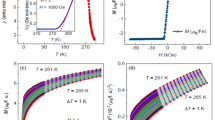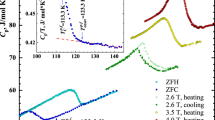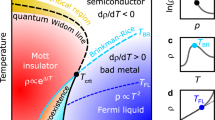Abstract
Paramagnets on the border of ferromagnetism at low temperatures are more subtle and complex than anticipated by the conventional theory of quantum critical phenomena. Could quantum criticality theory be more relevant in the corresponding case of quantum paraelectrics on the border of ferroelectricity? To address this question we have investigated the temperature dependence of the dielectric function of the displacive quantum paraelectrics SrTiO3, oxygen-18 substituted SrTiO3 and KTaO3. In all of these materials on the border of ferroelectricity we observe non-classical T2 temperature dependencies of the inverse dielectric function below 50 K, followed by anomalous upturns below a few kelvin extending into the millikelvin range. This non-classical behaviour can be understood quantitatively without adjustable parameters in terms of quantum criticality theory when extended to include the effects of long-range dipolar interactions and the coupling of the electric polarization field with acoustic phonons. The quantum critical regime in displacive ferroelectrics is thus strikingly different from that in the better-known ferromagnetic counterparts and offers unexpected prospects in the field of quantum phase transitions.
This is a preview of subscription content, access via your institution
Access options
Subscribe to this journal
Receive 12 print issues and online access
$209.00 per year
only $17.42 per issue
Buy this article
- Purchase on Springer Link
- Instant access to full article PDF
Prices may be subject to local taxes which are calculated during checkout





Similar content being viewed by others
References
Sachdev, S. Quantum Phase Transitions (Cambridge Univ. Press, 1999).
Focus on quantum phase transitions. Nature Phys. 4, 167–204 (2008).
Anderson, P. W. In praise of unstable fixed points: The way things actually work. Physica B 318, 28–32 (2002).
Fradkin, E. & Kivelson, S. Electron nematic phases proliferate. Science 327, 155–156 (2010).
Monthoux, P., Pines, D. & Lonzarich, G. G. Superconductivity without phonons. Nature 450, 1177–1183 (2007).
Rowley, S. E. et al. Novel metallic states at low temperatures. Low Temp. Phys. 37, 2–7 (2011).
Batista, C. et al. Geometric frustration and dimensional reduction at a quantum critical point. Phys. Rev. Lett. 98, 257201 (2007).
Jaime, M. et al. Magnetic-field-induced condensation of triplons in Han Purple pigment BaCuSi2O6 . Phys. Rev. Lett. 93, 087203 (2004).
Giamarchi, T., Rüegg, C. & Tchernyshyov, O. Bose–Einstein condensation in magnetic insulators. Nature Phys. 4, 198–204 (2008).
Kraemer, C. et al. Dipolar antiferromagnetism and quantum criticality in LiErF4 . Science 336, 1416–1419 (2012).
Muller, K. A. & Burkard, H. SrTiO3: Intrinsic quantum para-electric below 4 K. Phys. Rev. B 19, 3593–3602 (1979).
Lonzarich, G. G. Electron: A Centenary Volume, Ch. 6 (Cambridge Univ. Press, 1997).
Ueno, K. et al. Electric-field-induced superconductivity in an insulator. Nature Mater. 7, 855–858 (2008).
Kawasaki, M. et al. Discovery of superconductivity in KTaO3 by electrostatic carrier doping. Nature Nanotech. 6, 408–412 (2011).
Rechester, A. B. Contribution to the theory of second-order phase transitions at low temperatures. Sov. Phys. JETP 33, 423–430 (1971).
Khmelnitskii, D. E. & Shneerson, V. L. Low-temperature displacement-type phase transition in crystals. Sov. Phys. Solid State 13, 687 (1971).
Khmelnitskii, D. E. & Shneerson, V. L. Phase transition of the displacement type in crystals at very low temperature. Sov. Phys. JETP 37, 164–170 (1973).
Larkin, A. I. & Khmelnitskii, D. E. Phase transition in uniaxial ferroelectrics. Sov. Phys. JETP 29, 1123–1128 (1969).
Schneider, T., Beck, H. & Stoll, E. Quantum effects in an n-component vector model for structural phase-transitions. Phys. Rev. B 13, 1123–1130 (1976).
Bilz, H., Benedek, G. & Bussmann-Holder, A. Theory of ferroelectricity—the polarizability model. Phys. Rev. B 35, 4840–4849 (1987).
Kvyatkovskii, O. E. Quantum effects in incipient and low-temperature ferroelectrics (a review). Phys. Solid State 43, 1401–1419 (2001).
Roussev, R. & Millis, A. J. Theory of the quantum paraelectric–ferroelectric transition. Phys. Rev. B 67, 014105 (2003).
Coleman, P. Theory perspective: SCES ’05 Vienna. Physica B 378–80, 1160–1169 (2006).
Rowley, S. E. Quantum Phase Transitions in Ferroelectrics, Ph.D. thesis, (Univ. Cambridge, 2010)
Rowley, S. et al. Ferromagnetic and ferroelectric quantum phase transitions. Phys. Status Solidi B 247, 469–475 (2010).
Palova, L., Chandra, P. & Coleman, P. Quantum critical paraelectrics and the Casimir effect in time. Phys. Rev. B 79, 075101 (2009).
Das, N. & Mishra, S. G. Fluctuations and criticality in quantum paraelectrics. J. Phys. Conden. Mater. 21, 095901 (2009).
Conduit, G. J. & Simons, B. D. Theory of quantum paraelectrics and the metaelectric transition. Phys. Rev. B 81, 024102 (2010).
Aharony, A. & Fisher, M. E. Critical behavior of magnets with dipolar interactions. I Renormalization group near four dimensions. Phys. Rev. B 8, 3323–3341 (1973).
Lines, M. E. & Glass, A. M. Principles and Applications of Ferroelectrics and Related Materials (Clarendon, 2001).
Strukov, B. A. & Levanyuk, A. P. Ferroelectric Phenomena in Crystals: Physical Foundations (Springer, 1998).
Anderson, P. W. Conf. Proc., Lebedev Physics Inst. USSR Acad of Sci. Fizika Dielektrikov (Moscow) 290–297 (Nova Science Publishers, 1960).
Cochran, W. Crystal stability and the theory of ferroelectricity. Adv. Phys. 9, 387–423 (1960).
Wang, R. & Itoh, M. Suppression of the quantum fluctuation in 18O-enriched strontium titanate. Phys. Rev. B 64, 174104 (2001).
Itoh, M. & Wang, R. P. Quantum ferroelectricity in SrTiO3 induced by oxygen isotope exchange. Appl. Phys. Lett. 76, 221–223 (2000).
Venturini, E. L., Samara, G. A., Itoh, M. & Wang, R. Pressure as a probe of the physics of 18O-substituted SrTiO3 . Phys. Rev. B 69, 184105 (2004).
Anderson, P. W. Bose fluids above T c: Incompressible vortex fluids and ‘supersolidity’. Phys. Rev. Lett. 100, 215301 (2008).
Kubota, M., Shimizu, N., Yasuta, Y., Kitamura, A. & Yagi, M. Transition into the supersolid (SS) state, supersolid density ρ ss and the critical velocity V c to destroy the SS state. J. Low Temp. Phys. 162, 483–491 (2011).
Schooley, J. F. et al. Dependence of the superconducting transition temperature on carrier concentration in semiconducting SrTiO3 . Phys. Rev. Lett. 14, 305–307 (1965).
Pfeiffer, E. R. & Schooley, J. F. Superconducting transition temperatures of Nb-doped SrTiO3 . Phys. Lett. 29A, 589–590 (1969).
van der Marel, D., van Mechelen, J. L. M. & Mazin, I. I. Common Fermi-liquid origin of T2 resistivity and superconductivity in n-type SrTiO3 . Phys. Rev. B 84, 205111 (2011).
Li, L., Richter, C., Mannhart, J. & Ashoori, R. C. Coexistence of magnetic order and two-dimensional superconductivity at LaAlO3/SrTiO3 interfaces. Nature Phys. 7, 762–766 (2011).
Fischer, E. & Hegenbarth, E. Glasslike behaviour of SrTiO3 single-crystal at low temperatures. Ferroelectrics Lett. 5, 21–27 (1985).
Viana, R., Lunkenheimer, P., Hemberger, J., Bohmer, R. & Loidl, A. Dielectric spectroscopy in SrTiO3 . Phys. Rev. B 50, 601–604 (1994).
Uwe, H. & Sakudo, T. Stress-induced ferroelectricity and soft phonon modes in SrTiO3 . Phys. Rev. B 13, 271–286 (1976).
Yamada, Y. & Shirane, G. Neutron scattering and nature of the soft optical phonon in SrTiO3 . Phys. Soc. Jpn 26, 396–403 (1969).
Uwe, H. & Sakudo, T. Electrostriction and stress-induced ferroelectricity in KTaO3 . J. Phys. Soc. Jpn 38, 183–189 (1975).
Shirane, G., Nathans, R. & Minkiewicz, V. J. Temperature dependence of the soft ferroelectric mode in KTaO3 . Phys. Rev. 157, 396–399 (1967).
Shigenari, T. et al. Raman spectra of the ferroelectric phase of SrTi18O3: Symmetry and domains below Tc and the origin of the phase transition. Phys. Rev. B 74, 174121 (2006).
Takesada, M., Itoh, M. & Yagi, T. Perfect softening of the ferroelectric mode in the isotope-exchanged strontium titanate of SrTi18O3 studied by light scattering. Phys. Rev. Lett. 96, 227602 (2006).
Acknowledgements
We would like to thank M. A. Carpenter, G. Catalan, P. Chandra, G. Chapline, S. J. Chorley, P. Coleman, G. Conduit, J. P. Griffiths, M. Grosche, C. R. S. Haines, D. E. Khmelnitskii, K. H. Kim, P. B. Littlewood, C. Liu, N. Marcano, N. D. Mathur, N. P. Ong, L. Pálová, C. Panagopoulos, E. Saitovitch, B. D. Simons, D. J. Singh and I. R. Walker for their help and discussions. We would also like to acknowledge support from Emmanuel, Jesus and Trinity colleges of the University of Cambridge, the Engineering and Physical Sciences Research Council (EPSRC grant EP/K012894/1), the European Research Council (ESF) COST P16, the Princeton Center for Complex Materials, IHT KAZATAPROM and the INTELBIOMAT programme.
Author information
Authors and Affiliations
Contributions
The findings presented in this paper arose out of a cooperative effort of all the authors, who each played an essential role.
Corresponding authors
Ethics declarations
Competing interests
The authors declare no competing financial interests.
Supplementary information
Supplementary Information
Supplementary Information (PDF 1700 kb)
Rights and permissions
About this article
Cite this article
Rowley, S., Spalek, L., Smith, R. et al. Ferroelectric quantum criticality. Nature Phys 10, 367–372 (2014). https://doi.org/10.1038/nphys2924
Received:
Accepted:
Published:
Issue Date:
DOI: https://doi.org/10.1038/nphys2924
This article is cited by
-
Ultrafast entropy production in pump-probe experiments
Nature Communications (2024)
-
Cryogenic memory technologies
Nature Electronics (2023)
-
Competing electronic states emerging on polar surfaces
Nature Communications (2022)
-
Hall-Bulk photovoltaic effect in BiFeO3/SrTiO3 at low temperatures
Communications Physics (2022)
-
Non-collinear and asymmetric polar moments at back-gated SrTiO3 interfaces
Communications Physics (2022)



